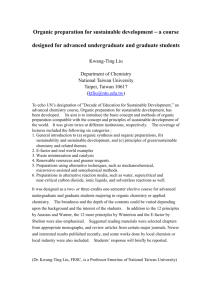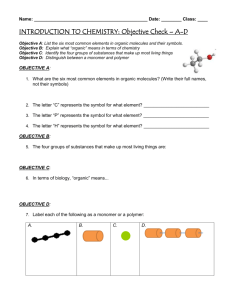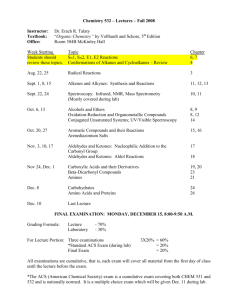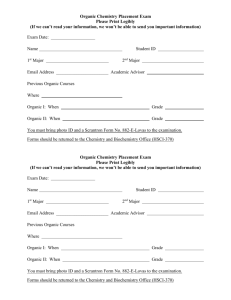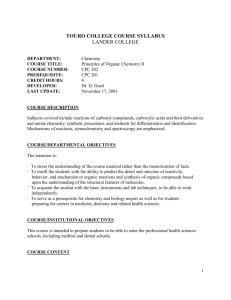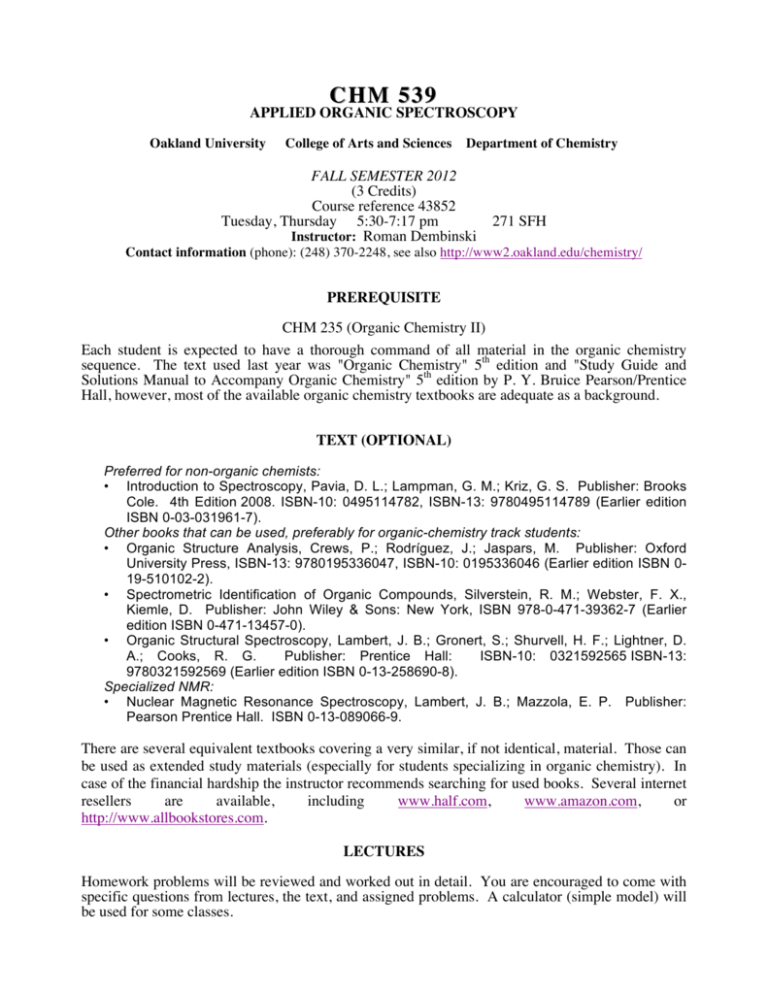
CHM 539
APPLIED ORGANIC SPECTROSCOPY
Oakland University
College of Arts and Sciences
Department of Chemistry
FALL SEMESTER 2012
(3 Credits)
Course reference 43852
Tuesday, Thursday 5:30-7:17 pm
Instructor: Roman Dembinski
271 SFH
Contact information (phone): (248) 370-2248, see also http://www2.oakland.edu/chemistry/
PREREQUISITE
CHM 235 (Organic Chemistry II)
Each student is expected to have a thorough command of all material
in the organic chemistry
th
sequence. The text used last year was "Organic Chemistry"
5
edition
and "Study Guide and
Solutions Manual to Accompany Organic Chemistry" 5th edition by P. Y. Bruice Pearson/Prentice
Hall, however, most of the available organic chemistry textbooks are adequate as a background.
TEXT (OPTIONAL)
Preferred for non-organic chemists:
• Introduction to Spectroscopy, Pavia, D. L.; Lampman, G. M.; Kriz, G. S. Publisher: Brooks
Cole. 4th Edition 2008. ISBN-10: 0495114782, ISBN-13: 9780495114789 (Earlier edition
ISBN 0-03-031961-7).
Other books that can be used, preferably for organic-chemistry track students:
• Organic Structure Analysis, Crews, P.; Rodríguez, J.; Jaspars, M. Publisher: Oxford
University Press, ISBN-13: 9780195336047, ISBN-10: 0195336046 (Earlier edition ISBN 019-510102-2).
• Spectrometric Identification of Organic Compounds, Silverstein, R. M.; Webster, F. X.,
Kiemle, D. Publisher: John Wiley & Sons: New York, ISBN 978-0-471-39362-7 (Earlier
edition ISBN 0-471-13457-0).
• Organic Structural Spectroscopy, Lambert, J. B.; Gronert, S.; Shurvell, H. F.; Lightner, D.
A.; Cooks, R. G.
Publisher: Prentice Hall:
ISBN-10: 0321592565 ISBN-13:
9780321592569 (Earlier edition ISBN 0-13-258690-8).
Specialized NMR:
• Nuclear Magnetic Resonance Spectroscopy, Lambert, J. B.; Mazzola, E. P. Publisher:
Pearson Prentice Hall. ISBN 0-13-089066-9.
There are several equivalent textbooks covering a very similar, if not identical, material. Those can
be used as extended study materials (especially for students specializing in organic chemistry). In
case of the financial hardship the instructor recommends searching for used books. Several internet
resellers
are
available,
including
www.half.com,
www.amazon.com,
or
http://www.allbookstores.com.
LECTURES
Homework problems will be reviewed and worked out in detail. You are encouraged to come with
specific questions from lectures, the text, and assigned problems. A calculator (simple model) will
be used for some classes.
OFFICE HOURS
There are no office hours. The instructor (SEB 225) prefers walk-ins.
COURSE GRADING
Homework will count as 44% of the course grade, practical instrumentation component 6%, and the
final exam will count as 50% of the course grade. Ranking (distribution curve) will be posted.
LECTURES PLAN
1. Analytical Methods in Organic Structure Analysis
2. Introduction into Nuclear Magnetic Resonance
3. Interpretation and Use of Proton and Carbon Chemical Shifts
4. Interpretation and Use of Proton and Carbon Coupling Constants
5. Multi-pulse and Multidimensional NMR Techniques
6. Electron Spin Resonance
7. Mass Spectrometry. Theory and Interpretation
8. Additional MS Techniques
9. Infrared Spectroscopy
10. Ultraviolet/Fluorescence Spectroscopy
11. Methods used to Determine Stereochemistry (CD, NMR, X-ray)
12. Problems in Structure Analysis
13. Practical Nuclear Magnetic Resonance
14. Practical Mass Spectrometry
FINAL EXAMINATION
Tuesday, December 11th, 271 SFH, 7:00-10.00 pm (registrar office schedule).
Proposed: Tuesday, December 11th, 271 SFH, 5:30-8.30 pm.
If you have a documented disability and wish to discuss academic accommodations, please contact
me as soon as possible.
-2-



